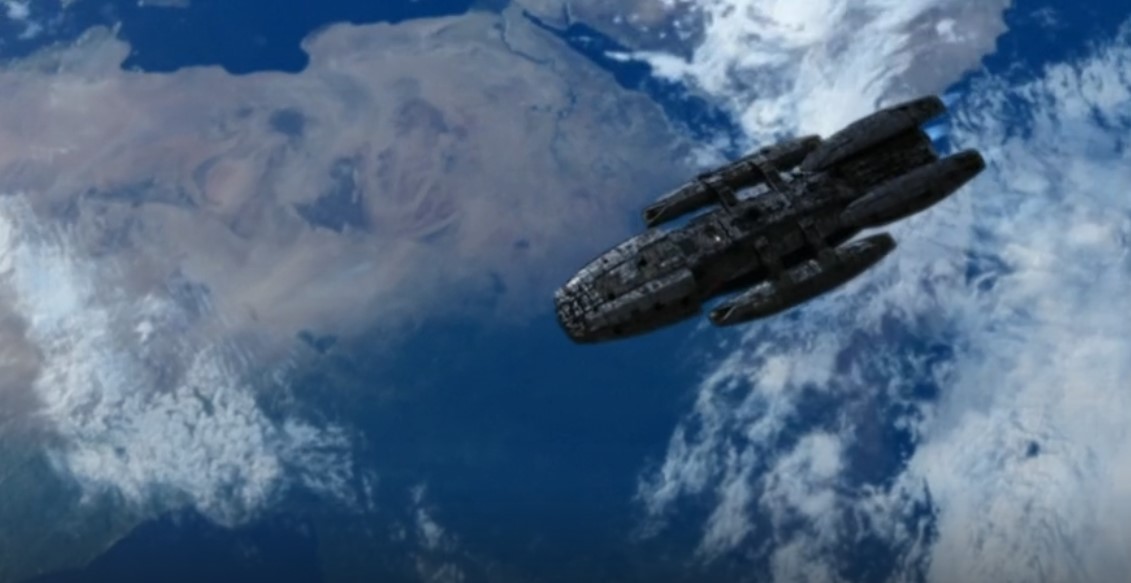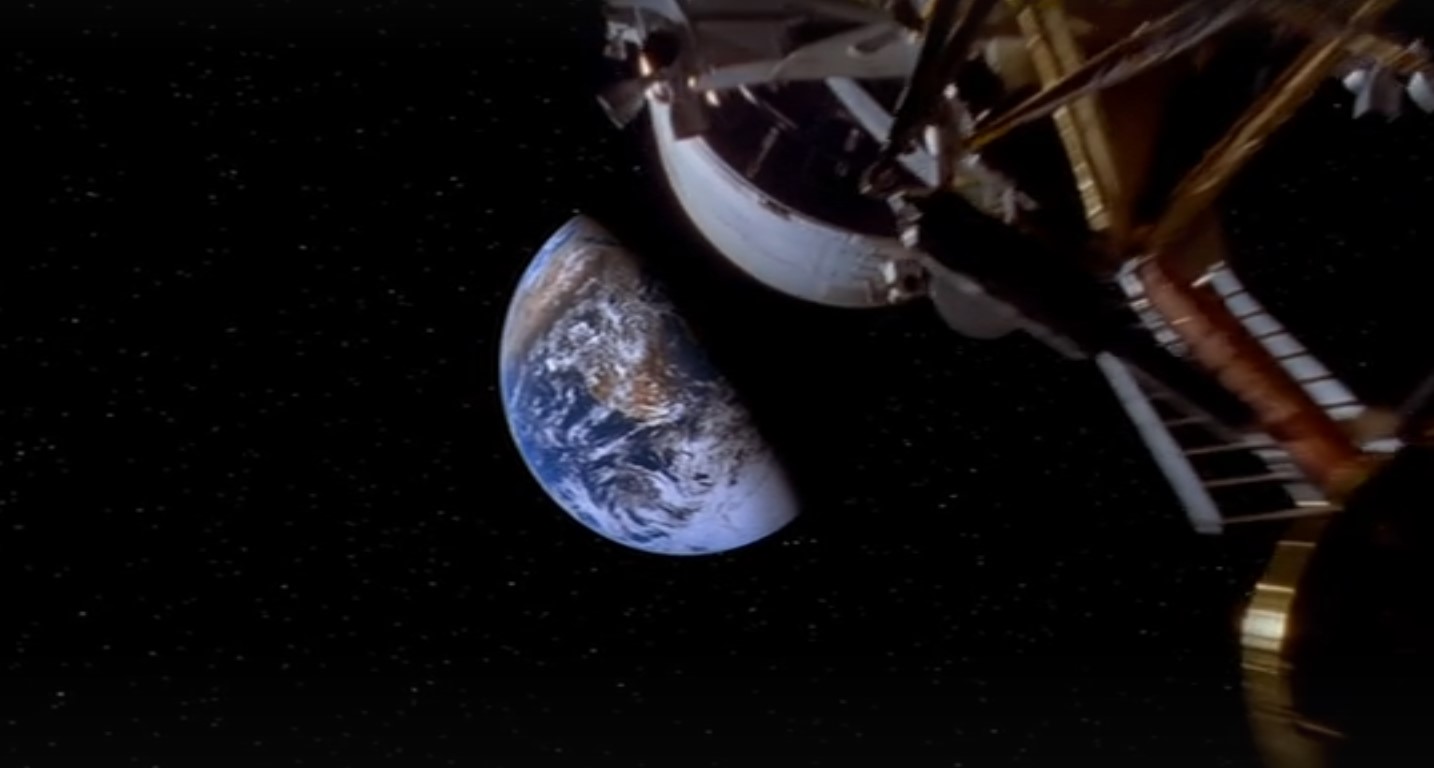Searching for a new home¶
Following the destruction of the 13 colonies, the remains of human civilisation form a small fleet, searching for a new home on a mythical planet called 'Earth'.
At one point, they believe they have found it - but this is clearly not our Earth!

Earth in Battlestar Galactica (left) and the blue marble image (right), taken by a different Apollo (NBCUniversal/NASA)
Although this Battlestar Galactica 'Earth' (on the left) looks plausible (that looks like Africa in the middle), it is pretty clear what is wrong.
When compared to a real picture of Earth taken by Apollo 17 (on the right), the Earth in Battlestar Galactica has almost no cloud!
A cloudy place¶
The Earth is pretty cloudy - at any one time, around two-thirds of the Earth are covered by cloud at any one time. Some places are almost completely covered by cloud! This is wildly different from the Earth in Battlestar Galactica, which is almost cloud-free.

A composite image of the global from the MODIS instrument. Those white bits are clouds (well, almost all of them). Image from NASA Worldview.
Overall rating: 2/10¶
Not enough clouds - That's not my Earth, it's not cloudy enough.

Earth is a dream ... one we’ve been chasing for a long time. We’ve earned it. This is Earth. Probably. (NBCUniversal)
More missing clouds¶
It is a bit unfair to pick on only Battlestar Galactica though. It is far from the only programme to get this wrong - this is one of the most common scientific mistakes on film and TV.
This is Captain Janeway and Seven of Nine from Star Trek Voyager (which previously scored a 8/10 for cloud science), talking infront of a nearly cloud-free Earth.

"There's coffee on that planet! But something about it looks a little ... strange." (Paramount)
In Star Trek IV [2], Captain Kirk arrives at an almost cloud-free North-East Pacific (this region is actually one of the cloudiest places on Earth).

"It's Earth Jim, but not as we know it" (Paramount Pictures)
Even Futurama, well known for its science content (including the "Futurama Theorem"), gets this wrong, showing an almost cloud-free Earth in several episodes.

"What's this layer of Ozone? That's never been there before. And where are all the clouds? Are you sure this is Earth?" (20th Century Fox)
This is not limited to TV or film either. Graphics of the Earth often show it with too few clouds - see this otherwise excellent Veritasium video on entropy.

Clouds are critical for the energy balance of the Earth, there should be more of them here (Veritasium)
The Good¶
It is not a universal issue though. Armageddon, a film noted for its scientific accuracy, does this right, with a cloudy Earth visible in the last few scenes.

We saved the Earth - and all the clouds too! (Touchstone Pictures)
Also known for scientific accuracy, the second Austin Powers film has an appropriately cloudy Earth.

Lots of clouds - yeah baby! (New Line Cinema)
The Expanse gets this correct too, with a cloudy Earth appearing just before part of it is blown up.

The railgun strike might have been a mistake - but Earth (and her clouds) must come first. (Syfy/Amazon Prime)
The Simpsons (a series with a history of cloud physics) also shows the Earth as being quite cloudy when Homer becomes an astronaut.

Orbiting the Earth in the Simpsons (crew includes the inanimate carbon rod). (20th Century Fox)
Apollo 13 does a bit of both. The computer graphics scenes showing the spacecraft use one view of the Earth that is cloudy, but doesn't have quite the normal distribution of clouds.

Apollo 13 heading home with a somewhat cloudy Earth (Universal)
Views from inside the spacecraft use an actual image of the Earth though - the blue marble itself!

That Earth is cloudy enough - it is actually a real picture! (Universal)
That shows us one way to have more accurate clouds in films.
How can I make my clouds accurate?¶
So if you are a film maker, how can you make sure your clouds are accurate? There are a few simple things to consider.
A cloudy Earth can still be recognised as Earth.
There are sensible reasons why you might want to make your Earth less cloudy - in particular, you might want to show enough land to make it clear to the audience that they are looking at Earth.
You don't need to do this though. Even a cloudy Earth is still easy to recognise as Earth, Look at this image from the EPIC instrument. Cloudy, but clearly Earth.

The Earth as viewed from about 1.5 million km (about 4 times as far as the Moon).
Don't forget the low clouds.
You want to include some clouds, but how do you do this? It might be tempting to add in a 'cloud layer' - unfortunately, these usually have too few clouds (e.g. the Natural Earth cloud layer).
At any time, half of the Earth is dark. With no light, you cannot detect clouds at night using the fact they are white. Instead you have to use infra-red to detect clouds by another property - they are cold.
Higher clouds are colder, making them stand out more clearly in infra-red, as you can see in the Meteosat images below. By relying on infra-red to detect clouds, you miss out many of the low clouds, as they are relatively warm and so difficult to detect. This gives your Earth too little cloud. [3]

A real satellite image of the Earth using visible light (left) and infra-red (right). Note how difficult it is to see some of the clouds in the infra-red image. These are the low clouds and are easy to forget.
Use real data
This might seem straightforward, but the easiest way to avoid these issues is to use real pictures and data!
For anything in low Earth orbit, the NASA astronaut photography gateway has a large number of views of the Earth.
Further away than that, the geostationary weather satellites (GOES, MSG, Himawari) produce amazingly detailed views of the Earth (complete with clouds).
Further still, the EPIC instrument takes nice pictures of Earth, but only the sunlit side.
There is also the NASA Visible Earth cloud composite, which you can use to build an accurate-looking Earth.

If all else fails, you can just use the blue marble! (Paramount)
This doesn't solve everything, but I am happy to offer my services as a cloud consultant - feel free to get in touch.
Comments by email
Notes¶
| [1] | Most of these are scifi or animation - there are not many views of the Earth from space in other genres. Let me know if you find any though! |
| [2] | The one with the whales |
| [3] | The Star Trek Voyager, Star Trek IV and Veritasium examples above have likely done this (although not being involved in production, I can't be sure). |